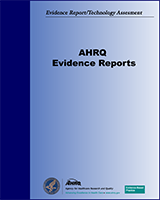NCBI Bookshelf. A service of the National Library of Medicine, National Institutes of Health.
ECRI Health Technology Assessment Group. Diagnosis and Treatment of Swallowing Disorders (Dysphagia) in Acute-Care Stroke Patients. Rockville (MD): Agency for Health Care Policy and Research (US); 1999 Jul. (Evidence Reports/Technology Assessments, No. 8.)
This publication is provided for historical reference only and the information may be out of date.

Diagnosis and Treatment of Swallowing Disorders (Dysphagia) in Acute-Care Stroke Patients.
Show detailsThe worth of a diagnostic test is inextricably bound up with the effectiveness of the treatment being given based on the results of the test. Therefore, clinical trials measuring after-treatment outcomes are preferable in assessing the impact of the test. The problem with this approach is that effective treatment will decrease the apparent effectiveness of the test.
This is best illustrated by the example tabled below, which represents the results of a hypothetical diagnostic test.
| Patient's Actual Condition | ||||
|---|---|---|---|---|
| Test Result | Positive | 20 TP | 10 FP | 67% PPV |
| Negative | 10 FN | 60 TN | 86% NPV | |
| 67% sensitivity | 86% specificity | |||
Now assume that a treatment is added between the time of the test and the time the outcome (patient's condition) is measured. The treatment would be given only to those who test positive. Assume also that the treatment is 50 percent effective, so out of the 20 patients with a true-positive (TP) test result, the condition of 10 will change from positive to negative. [The 10 false-positive (FP) cases will also get treated, but since these patients do not have the disease in question, the treatment has no effect on patient outcome.] The results of this hypothetical trial are shown in the table below.
| Patient's Actual Condition | ||||
|---|---|---|---|---|
| Test Result | Positive | 10 TP | 20 FP | 33% PPV |
| Negative | 10 FN | 60 TN | 86% NPV | |
| 50% sensitivity | 75% specificity | |||
Notice that sensitivity and specificity both decreased as a result of treatment. Positive predictive value (PPV) decreased substantially, but negative predictive value (NPV) was unchanged.
The magnitude of this treatment bias depends on the effectiveness of treatment. If the hypothetical treatment were 100 percent effective, then all 20 true positives will become false positives, and the sensitivity and PPV will both fall to zero:
| Patient's Actual Condition | ||||
|---|---|---|---|---|
| Test Result | Positive | 0 TP | 30 FP | 0% PPV |
| Negative | 10 FN | 60 TN | 86% NPV | |
| 0% sensitivity | 67% specificity | |||
Treating all patients regardless of test results will not eliminate this bias. It will, however eliminate its effect on sensitivity because the numbers of true positives and false negatives (FN) will each be reduced by the same proportion (treatment effectiveness). This is shown in the table below.
| Patient's Actual Condition | ||||
|---|---|---|---|---|
| Test Result | Positive | 10 TP | 20 FP | 33% PPV |
| Negative | 5 FN | 65 TN | 93% NPV | |
| 67% sensitivity | 76% specificity | |||
Treatment, if given to all patients, will almost always cause PPV to decrease and NPV to increase. Sensitivity will be unchanged, while specificity will decrease. Exceptions to this rule exist when the test results are actually worse than chance. (We stress, however, that such a test is unlikely to ever be used in clinical practice.) In this case, specificity would increase, as shown in the table below.
| 10 TP | 20 FP | 33% PPV | 5 TP | 25 FP | 17% PPV | |
| 40 FN | 30 TN | 43% NPV | 20 FN | 50 TN | 71% NPV | |
| 20% sensitivity | 60% specificity | 20% sensitivity | 67% specificity |
- Appendix G. The Effect of Treatment on Diagnostic Test Results - Diagnosis and T...Appendix G. The Effect of Treatment on Diagnostic Test Results - Diagnosis and Treatment of Swallowing Disorders (Dysphagia) in Acute-Care Stroke Patients
- Appendix B. Burden of Illness of Dysphagia and Its Complications in Neurologic D...Appendix B. Burden of Illness of Dysphagia and Its Complications in Neurologic Diseases - Diagnosis and Treatment of Swallowing Disorders (Dysphagia) in Acute-Care Stroke Patients
Your browsing activity is empty.
Activity recording is turned off.
See more...